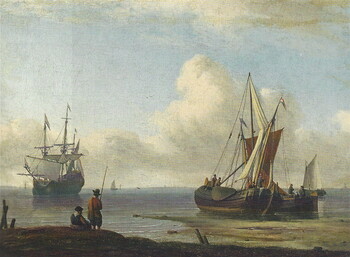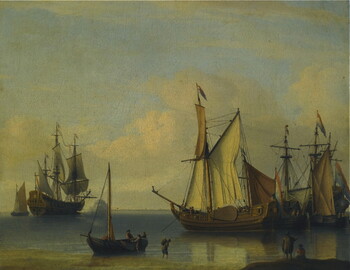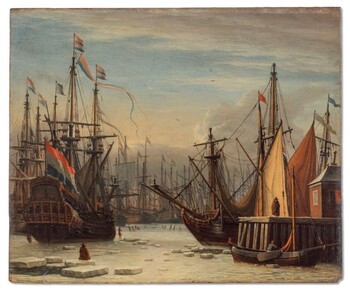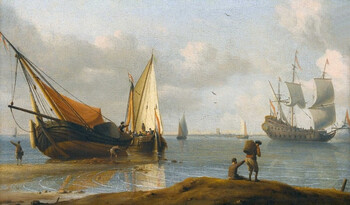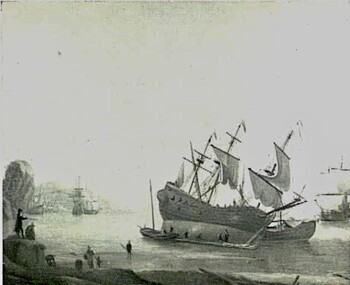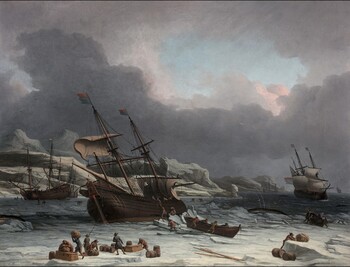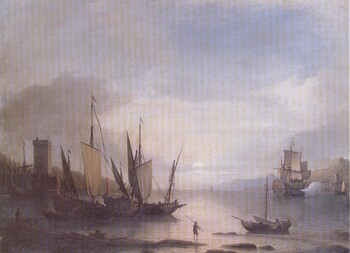A crew caulking the hull of a Dutch merchant vessel
Oil on canvas : 80,2 X 106,7 cm
Signed bottom middle “A.Smit”
Wooden sculpted frame : 96,8 X 123,9 cm
Our painting is recorded at the RKD, The Hague, number 40159.
Provenance : sold at Sotheby’s London, 7/06/1950.
Our painting is recorded at the RKD, The Hague, number 40159.
Provenance : sold at Sotheby’s London, 7/06/1950.
In short
Aernout Smit was a pupil of Jan Theunisz. Blanckerhoff (1628 – 1669). Like his master he had been a sailor and he had travelled extensively before turning to painting. His knowledge of the maritime world explains why he is known to have painted several attractive scenes, such as ours, of the maintenance of a ship: men caulking the hull (in dutch “kalefateren”), making it waterproof. This rare subject was also painted by just a few other contemporary Dutch painters (such as Nooms and Bakhuizen); it is very sought-after by collectors.
About Aernout Smit
Dutch marine painter
Amsterdam (?) 1641 – 1710 Amsterdam
Pupil of Jan Theunisz. Blanckerhoff (Alkmaar 1628 – 1669 Amsterdam).
Blanckerhoff is documented in Amsterdam between 1659 and 1666.
It would appear that Aernout Smit travelled extensively, as some of his pictures of both the Mediterranean shores and of Greenland were probably painted from nature. His master Jan Theunisz. Blanckerhoff had also travelled to Italy and Greece. Apparently three 17th century Dutch marine painters, Blanckerhoff, Smit and Reinier Nooms (1623 – 1667 or later), had started working as sailors, as shipmates, before turning to painting. Their first-hand knowledge of shipping and far-away places in the Mediterranean is reflected in their accurate records of ships and of topographical views.
Smit’s early works, often of small dimensions, are characterized by light grey tonalities and a very good perspective. Most of them represent Mediterranean shores, occasionally Dutch waters. Our painting dates from after this successful start of his career; he must have painted it during the early 1670s.
Later in his career Smit became strongly influenced by Ludolf Backhuysen (1630 – 1708), the most important Dutch marine painter of the later part of the 17th century active in Holland (Willem van de Velde II had moved to England in 1672). Under his influence his marine paintings became more colourful.
Smit is mentioned in a document of 1688 as a member of the Amsterdam Painter's Guild of Saint Luke.
About caulking
Caulking (“kalefateren” in dutch) is a technique in which the gaps between the planks of the hull or between the planks of the upper deck of a ship are sealed using pitch (a natural fibre rope, usually hemp) and pitch or tar. The waterproof seal is based on the property of natural fibres swelling when they absorb moisture. This seals any leaks by the water that seeps in.
Why should you buy our painting?
Because one expects to see these fragile tonalities that are so typical of Smit. When we bought the painting they went hidden under a thick, dirty layer of yellowed varnish.
Comparative paintings
Click photos for more details

